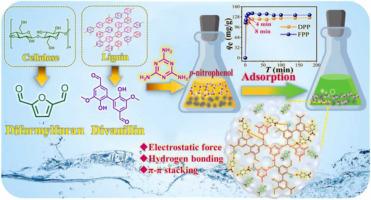Industrial Crops and Products ( IF 5.9 ) Pub Date : 2022-05-05 , DOI: 10.1016/j.indcrop.2022.114971 Yunlong Liu 1, 2 , Xuan Zhou 1, 2 , Can Jin 1 , Guifeng Liu 1 , Zengshe Liu 3 , Zhenwu Kong 1

|
Removing phenolic compounds from water resources is urgent as they have seriously damaged aquatic ecological equilibrium. In this study, divanillin-based porous organic polymers (DPP) and 2,5-furandicarboxaldehyde-based porous organic polymers (FPP) were prepared from sustainable lignocellulose-derivatized monomers using a one-step synthetic method. The characterization highlighted the large Brunauer–Emmett–Teller (BET) surface area (SBET 513.9 and 772.8 m2∙g−1), mainly mesoporous property (3.4 and 6.5 nm) and high nitrogen content (over 25%) of the obtained DPP and FPP, which rendered them high adsorption affinity toward phenolic pollutants. Specifically, DPP and FPP exhibited the highest adsorption capacity for p-nitrophenol (PNP) (254.2 and 339.4 mg∙g−1) calculated by the Langmuir isotherm model. The porous networks of DPP and FPP enabled fast sorption kinetics for PNP with adsorption equilibrium times of only 8 and 4 min, respectively. Thermodynamic investigation revealed adsorption followed spontaneous and exothermic chemisorption processes. The interaction between the PNP and DPP/FPP mainly involved the synergism of hydrogen-bonding interactions, electrostatic force, and π-π stacking interactions. Furthermore, DPP and FPP exhibited outstanding durability and retained over 78.9% and 81.9% removal efficiency for PNP after ten cycles. Therefore, these biobased materials with high adsorption capacity and rapid adsorption rate show promising application in wastewater treatment.
中文翻译:

使用生物基多孔有机聚合物高效快速地去除水中的典型酚类化合物
由于酚类化合物严重破坏了水生生态平衡,因此从水资源中去除酚类化合物迫在眉睫。在这项研究中,使用一步合成方法从可持续的木质纤维素衍生单体制备了基于联香草醛的多孔有机聚合物 (DPP) 和基于 2,5-呋喃二甲醛的多孔有机聚合物 (FPP)。表征突出了大的 Brunauer-Emmett-Teller (BET) 表面积(S BET 513.9 和 772.8 m 2 ∙g -1),主要是中孔性质(3.4 和 6.5 nm)和高氮含量(超过 25%)获得的DPP和FPP,这使得它们对酚类污染物具有高吸附亲和力。具体来说,DPP 和 FPP 对对硝基苯酚 (PNP) 的吸附容量最高(254.2 和 339.4 mg∙g-1 ) 由 Langmuir 等温线模型计算。DPP 和 FPP 的多孔网络实现了 PNP 的快速吸附动力学,吸附平衡时间分别仅为 8 分钟和 4 分钟。热力学研究表明吸附遵循自发和放热化学吸附过程。PNP与DPP/FPP之间的相互作用主要涉及氢键相互作用、静电力和π-π堆积相互作用的协同作用。此外,DPP 和 FPP 表现出出色的耐用性,并且在 10 次循环后对 PNP 的去除效率保持在 78.9% 和 81.9% 以上。因此,这些具有高吸附容量和快速吸附速率的生物基材料在废水处理中显示出广阔的应用前景。



























 京公网安备 11010802027423号
京公网安备 11010802027423号